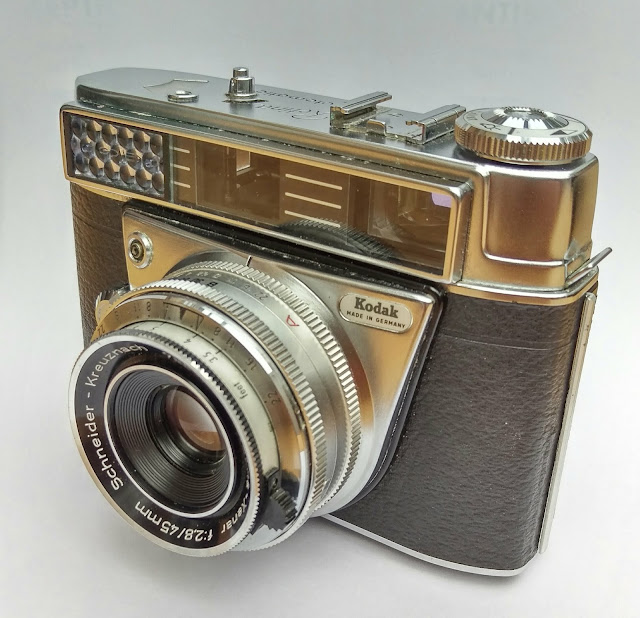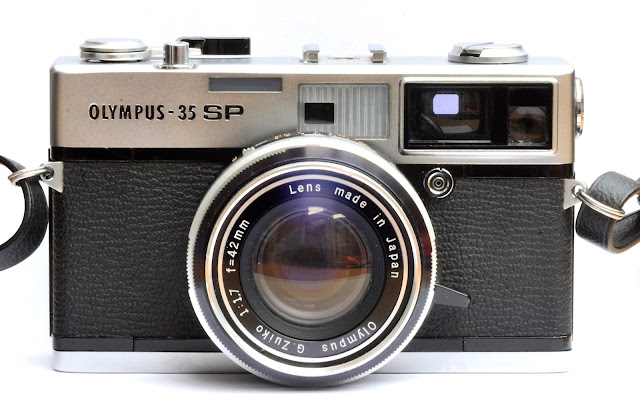Kodak Retina Automatic III
I have a confession to make. I have worked for Kodak Ltd in the UK since 1979. Therefore I need to declare my interest when I review any Kodak products. The purchase of this camera was driven by my interest in Kodak's history. The camera was manufactured in Stuttgart, Germany at about the same time that I was born. Therefore double interest. I picked this fully working example up on Ebay for £25.
The Kodak Retina range of 35mm cameras are well known in photography. They were produced between the mid-thirties right up until the end of the sixties. There is plenty of information on the whole series on the internet and they are relatively easy to pick up at a reasonable price. The model that I am looking at here is a Kodak Retina Automatic III.
The camera comes in a good looking hard leather case with silver chrome trim and red velvet and plastic lining. The top of the case cannot be separated from base but the whole case can be removed from the camera using the knurled screw on the base of the camera. As you can see from the picture above it is an attractive camera that also feels good in the hand.
The Retina Automatic III is a rangefinder camera with built in light meter that enables automatic exposure. It has a Schneider-Kreuznach Xenar f2.8 45mm lens. It can work in shutter priority mode or manual mode. Shutter speeds run from 1/30th to 1/500th of a second plus B. Apertures available are f2.8 to f22. Shutter speed and aperture are selected by turning the appropriate rings on the lens. The ISO of the film is set by depressing a small metal button on the bottom of the lens whilst at the same time turning the shutter speed ring on the lens. ISO values run from 10 to 1250. DIN numbers are also shown.
Focusing is achieved by turning the front of the lens and using the rangefinder central spot in the viewfinder to line up two images. If you have never used a rangefinder this sounds a bit odd but in use it is actually easy to use and provides fast focusing. The time it will be problematic is in low light or subjects with very few defining lines or points. One interesting feature of this Retina is that the wind on lever in on the bottom of the camera. This feels odd at first as we are all used to a top plate wind on lever but after a little use it feels more natural. I find I start the wind on stroke with my third finger and finish it off with my thumb. Another feature that is different to a lot of cameras is that the shutter release is not a button on the top plate but a knob/lever at the side of the lens. Again once you get used to this it isn't a problem.
The frame counter is also an interesting device. It is located on the top plate and counts down from a number that you set when the film is loaded. The number is set by depressing the button next to the frame counter whilst simultaneously pushing a button on the back of the camera sideways to the right. This moves the counter round and you set it to the number of exposures on the film. When the counter gets to zero the wind on lever locks so no further pictures can be taken. Therefore it pays to set the counter once the film has been loaded and the film has been wound on a couple of times.
The top plate also has the light meter needle read out. The numbers on the meter show f stop numbers. Therefore you can set the shutter speed on the lens and then look at the readout on the meter to show which aperture to use. You cannot see the meter while looking through the viewfinder so you have to point the camera in the right direction to get the reading and set the correct exposure.
On the bottom of the camera is the back opening lock. This is a button that hides underneath the turnable 'wings' of the tripod mounting hole. It works very well as accidental opening of the back is almost impossible and most people who handle the camera for the first time cannot work out how to open the back.
So what's it like to use? First off it looks smart on your shoulder. When you open the case and show the camera itself it gets looks and comments from people. A lot of people will comment on how they used to use a Kodak Retina, usually during the sixties. It raises a smile and people don't seem scared of it, perhaps like they would be with an SLR/DSLR and big lens. If set on automatic it is simply a case of framing and focusing. Wind on and release the shutter. The shutter makes a slightly tinny click but it is a satisfying sound none the less. Using the in built light meter in manual mode is slightly trickier as mentioned before. You really need to use the camera in a similar way to a separate light meter. It does work but it is a little slow. Shutter priority mode is easy to use.
The pictures below were taken early on a January morning in fairly flat lighting using Kodak Colorplus 200. As you can see there is no issue with exposure or focus.
The Three Horseshoes, Winkwell, Bourne End
Watford Library in better lighting conditions
Good exposure for a snow shot (after a large part of the tree in my garden came down)
Overall I found the Kodak Retina Automatic III very satisfying to use and was very happy with the results it produced. The light meter is a selenium cell so it doesn't need a battery. The 45mm lens is an ideal focal length for general photography. For £25 pounds I think I got my self a bargain. I'm now looking to see if I can use the camera to create a story for my company's intranet. A 55 year old camera using film producing results as good as the day it was made. I wonder if my Nikon D7000 will be doing that (not with film obviously!).















Comments
Post a Comment